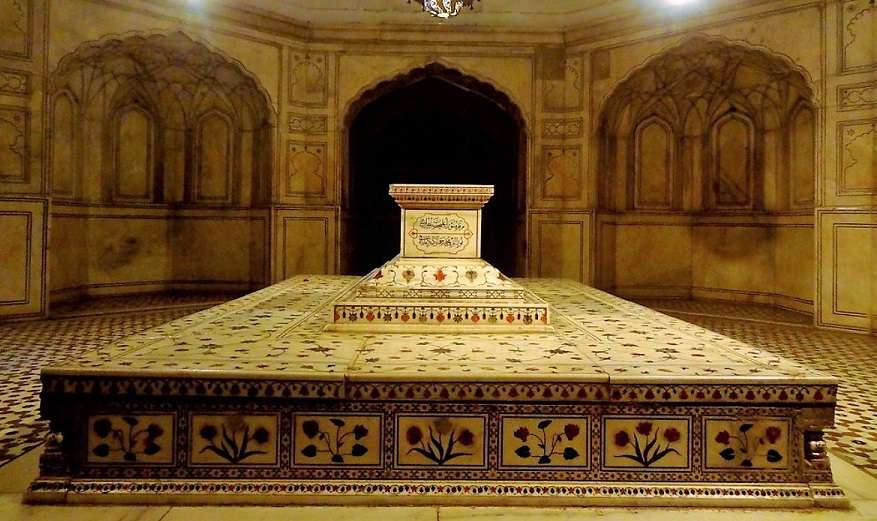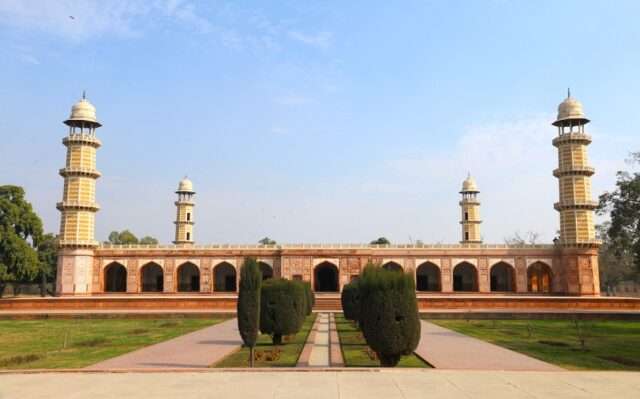Tomb of Jahangir – A Mughal Empire’s Virtue is mausoleum of the Mughal Emperor Jahangir that was constructed in the 17th century.
The tomb is situated in Shahdara Bagh, Lahore, near the banks of the Ravi River, and it was built in 1637.
The place is renowned for both its outside, which is magnificently embellished with pietra dura, and its interiors, which are richly furnished with paintings and marble.
The mausoleum is a part of a complex that is currently on the provisional list for UNESCO World Heritage designation, along with the neighboring Akbari Sarai and the Tomb of Asif Khan.
Location
Northwest of Lahore’s Walled City is Shahdara Bagh, where the tomb is situated. From Lahore, the tomb is located across the River Ravi.
The mausoleum is located in Nur Jahan’s cherished Dilkusha Garden, which was established in 1557.
Nearby to Asif Khan’s mausoleum is the grave of Jahangir’s wife Nur Jahan. The interior of the tomb is largely covered in artwork from the Mughal Empire.
History
Emperor Jahangir, who ruled the Mughal Empire from 1605 until 1627 CE, had the tomb built for him. On October 28, 1627, the emperor passed away in the Kashmiri hills close to the town of Rajouri.
On Friday, November 12, 1627, his remains was transported from Kashmir to Lahore in a funeral procession. When Jahangir and his wife Nur Jahan lived in Lahore, the Dilkusha Garden, where he was interred, was one of their “favorite spots,” they said.
His son, the new Mughal Emperor Shah Jahan, commanded the construction of a “tomb appropriate an Emperor” to house his father’s remains.
Emperor Jahangir forbade a dome from being built over his tomb.

Although modern historians attribute the building of the mausoleum to Jahangir’s son Shah Jahan, Nur Jahan’s proposal may have been the driving force behind its creation.
She is supposed to have designed the tomb in 1627, drawing inspiration from her father’s final resting place, and she likely contributed to its construction. Beginning in 1627, the project took ten years to complete and cost Rs 10 lakh.
Sikh court documents show that the tomb’s restoration efforts began around 1814. However, the burial complex was similarly dishonored during Sikh control when it was looted by Ranjit Singh’s army and its building components were taken to adorn the Golden Temple in Amritsar.
After that, Senior Oms, also known as Musa Sahib, an officer in Ranjit Singh’s army, transformed the looted lands into a private residence.
When Ranjit Singh mandated that Musa Sahib be interred on the mausoleum’s grounds after passing away from cholera in 1828, he further desecrated the structure.
Although there is no evidence to suggest that a dome or second story ever existed at the tomb, by 1880 a rumor had started to circulate that the tomb formerly had a dome or second story that had been plundered by Ranjit Singh’s soldiers.
Jangir Tomb’s construction
During Jahangir’s rule, there was a revived interest in Timurid design, as evidenced by the employment of spires.
Marble carvings are used to embellish the tomb’s walls. Tomb of Jahangir – A Mughal Empire’s Virtue is a landmark in architecture.
The tomb was constructed in a Mughal style that was influenced by Safavid architecture from Persia. Nur Jahan, who was of Farsi descent, may have introduced this style into the Mughal Court.
The grave is displayed as a takhtgah, or a tomb constructed upon a platform that doubles as a takht, or “throne.” In contrast, neither a takhtgah on the stage nor any indication that one had existed.
Jahangir’s mausoleum, like Akbar’s, is devoid of a central dome because the Emperor is said to have expressly forbidden building a dome above his grave.
The first dome in a Mughal funerary building was utilized in the Tomb of Humayun, and Shah Jahan revived the practice.
Babur, Jahangir’s great-grandfather, indicated to be buried in a tomb exposed to the sky at the Gardens of Babur in accordance with Sunni Islamic practice.
With this custom, Jahangir’s tomb is lacking by having a roof. Jahangir specifically prohibited the building of a dome over his tomb in order to reach a compromise with Sunni tradition.
The tomb’s perimeter is surrounded by curved coves that are modelled after Central Asian Timurid architectural designs.
White marble phony melodies are used to embellish the red sandstone façade of the tomb. Tomb of Jahangir – A Mughal Empire’s Virtue is one of the tourist places in Lahore.
Four ornate minarets in the shape of octagons rise from the edifice, one at each corner, and are adorned with geometric stone carvings.
Minarets were not used in early Mughal orders, but during Jahangir’s rule, there was a renewed interest in Timurid architecture from Central Asia.
The minarets are separated into three portions, with the tomb serving as the base and the minaret’s body, which is covered with white marble domes, resting on top. The 100-foot height of the minarets (30m).
The gardens surrounding the mausoleum are designed in the Persian Chahar Bagh style. Tomb of Jahangir – A Mughal Empire’s Virtue.
The expansive gardens that surround the tomb are designed in the Persian Chahar Bagh, often known as the Heaven garden.
In order to represent the four rivers that flow in Jannat, the Islamic concept of paradise, the garden is split into four squares by concrete walks and two central water channels that cut across them.
A total of 16 squares are created when the four squares are further divided into smaller squares by paths. The garden creates a courtyard with sides that are almost 500 meters long.
The Emperor’s cenotaph is located in the burial chamber.
Architecture of the Tomb
The tomb structure is divided into several domed chambers that are lavishly decorated with Mughal bon painting.
The Mughal Emperor’s remains are interred in a crypt beneath a cenotaph in the center of the mausoleum, which is octagonal in shape and lined with sculpted marble.
The 99 Names of Allah, a common motif in Islamic theology, are depicted on a white-marble monument that is embellished with pietra dura in botanical patterns inside the tomb.
The main activities of this restoration project include restoring and beautifying Jahangir tomb, building a lake nearby, installing a chairlift to make it easier for people to approach the monument, and opening a museum featuring Mughal-era items.
As the only intact Mughal tomb in Pakistan, the mausoleum of Jahangir is unique among the country’s remaining examples of architecture. It continues to be the most visited sight in Lahore, and its image may be found on the national currency.











